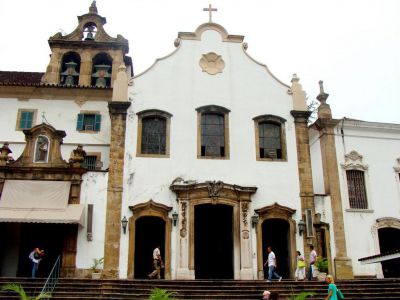Santo Antônio Convent, Rio de Janeiro
The Convent of Santo Antonio is a Catholic monastery that belongs to the Franciscan Province of the Immaculate Conception of Brazil. It is situated on top of Santo Antônio Hill, overlooking the Largo da Carioca square in the heart of Rio de Janeiro. This convent, along with the nearby Church of the Third Order of São Francisco da Penitência, constitutes one of the oldest and most significant colonial establishments still standing in the city.
Inside the church, you'll find a simple and traditional design. It has a rectangular shape and features a single nave. The main chapel and side altars are adorned with gilded woodwork that dates back to the period between 1716 and 1719. This woodwork exhibits a late Baroque style that is more characteristic of the 17th century than the 18th century.
The history of the Convent of Saint Anthony can be traced back to 1592 when the first Franciscans arrived in Rio de Janeiro. One of its notable features is its catacombs, where the remains of several members of the Imperial Family are laid to rest.
Inside the church, you'll find a simple and traditional design. It has a rectangular shape and features a single nave. The main chapel and side altars are adorned with gilded woodwork that dates back to the period between 1716 and 1719. This woodwork exhibits a late Baroque style that is more characteristic of the 17th century than the 18th century.
The history of the Convent of Saint Anthony can be traced back to 1592 when the first Franciscans arrived in Rio de Janeiro. One of its notable features is its catacombs, where the remains of several members of the Imperial Family are laid to rest.
Want to visit this sight? Check out these Self-Guided Walking Tours in Rio de Janeiro. Alternatively, you can download the mobile app "GPSmyCity: Walks in 1K+ Cities" from Apple App Store or Google Play Store. The app turns your mobile device to a personal tour guide and it works offline, so no data plan is needed when traveling abroad.
Santo Antônio Convent on Map
Sight Name: Santo Antônio Convent
Sight Location: Rio de Janeiro, Brazil (See walking tours in Rio de Janeiro)
Sight Type: Religious
Guide(s) Containing This Sight:
Sight Location: Rio de Janeiro, Brazil (See walking tours in Rio de Janeiro)
Sight Type: Religious
Guide(s) Containing This Sight:
Walking Tours in Rio de Janeiro, Brazil
Create Your Own Walk in Rio de Janeiro
Creating your own self-guided walk in Rio de Janeiro is easy and fun. Choose the city attractions that you want to see and a walk route map will be created just for you. You can even set your hotel as the start point of the walk.
Rio de Janeiro Introduction Walking Tour
Rio de Janeiro is the capital city of the state of Rio de Janeiro. It was founded in 1565 by the Portuguese. It was the capital of the State of Brazil of the Portuguese Empire from 1763 until 1822.
When Brazil became independent of Portugal in 1822, Rio de Janeiro became the capital of the Empire of Brazil. In 1889, Brazil became a republican nation, with Rio de Janeiro as its capital. But in... view more
Tour Duration: 3 Hour(s)
Travel Distance: 4.0 Km or 2.5 Miles
When Brazil became independent of Portugal in 1822, Rio de Janeiro became the capital of the Empire of Brazil. In 1889, Brazil became a republican nation, with Rio de Janeiro as its capital. But in... view more
Tour Duration: 3 Hour(s)
Travel Distance: 4.0 Km or 2.5 Miles
Rio's Top Religious Sites
Due to the legacy of the Portuguese in language, religion, and law, Rio de Janeiro has had a rich and influential Catholic tradition. Until the mid-20th century almost all Brazilians were – at least nominally – Catholic, and today the country’s religious sites, both classic and modern, impress with their skill, creativity and devotion.
Founded in 1590 by Benedictine monks from Bahia, the... view more
Tour Duration: 2 Hour(s)
Travel Distance: 3.0 Km or 1.9 Miles
Founded in 1590 by Benedictine monks from Bahia, the... view more
Tour Duration: 2 Hour(s)
Travel Distance: 3.0 Km or 1.9 Miles
Rio de Janeiro Beach Walk
The Copacabana and Ipanema beaches are two of the main reasons Rio is so famous around the world. While Copacabana is a year-round tourist hub, famed for its incredible New Year’s Eve celebrations, the Ipanema and Leblon neighborhoods have the cleanest, safest, most beautiful beaches in the city, and are the favorite playgrounds of Rio de Janeiro’s upper-middle class.
Start your tour with a... view more
Tour Duration: 2 Hour(s)
Travel Distance: 4.9 Km or 3 Miles
Start your tour with a... view more
Tour Duration: 2 Hour(s)
Travel Distance: 4.9 Km or 3 Miles
Useful Travel Guides for Planning Your Trip
16 Uniquely Brazilian Souvenirs to Bring Home from Rio de Janeiro
Other than the sun, passion and football, for which Brazil is renowned and which cannot be fitted into one's luggage, picking a memorable gift from Rio is a tough job. And this is not because of the lack of suitable things to choose from, but because of their abundance. Indeed, there're...







